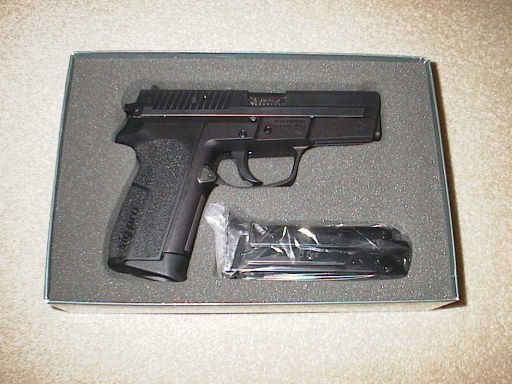
[This review originally appeared on the Deactivated Guns Collector’s Association website in December 2003 – Ed.]
And continuing what appears to be a long series on pistols made by Sauer in Germany, we come to the SIG Pro SP2009, their first attempt at making a pistol with a plastic (oops, polymer) frame.
Before I get to the juicy technical details, some explanation of the name of this pistol is in order. Although the gun is made by Sauer, it’s called the “SIG Pro” because when it first came out, Sauer was owned by the Swiss conglomerate SIG, but in the middle of 2000, they sold their arms division off to a private investors group called: “Swiss Arms”, who have allowed each branch of the arms division to operate as separate companies. Therefore, although SIG has nothing to do with them anymore, the US branch is still called: “SIG Arms”, and the name of this pistol still has: “SIG” in it as well, because it came out in 1999 when SIG still owned Sauer. Following? Just to make things even more confusing, the frames of the first 50,000 or so SIG Pros were made at the SIG plant in Neuhausen, Switzerland, but after Swiss Arms took over, the tooling was moved to the Sauer plant in Germany. So if you have an early SIG Pro it has “Frame made in Switzerland” stamped on the frame. Just to be precise, the .40 S&W calibre version was released prior to the 9mm version, and came out in the middle of 1998.
Anyway, SIG are probably crying in their cornflakes now (after all, they make the packaging for them), because in May 2003, Sauer won a contract with the French Ministry of the Interior to supply them with 270,000 SIG Pros, yes, you read that right, two hundred and seventy thousand pistols, which apparently makes it the largest single contract award for handguns since World War Two! It’s amazing what the election of a right-wing government during a crime wave can do, isn’t it? Although it is a hell of a lot of guns, it’s a bit of a misleading figure as police contracts for guns are usually awarded at the State or local level in most countries, and the US Dept. of Defense has actually acquired more Berettas than that, but under a series of contracts. However, to put this figure in perspective, bear in mind that prior to the handgun ban in GB, there were only 200,490 handguns possessed privately, and that included unused authorisations to acquire them! Even if you chuck in all the guns owned by the police, it still doesn’t come to 270,000!
So during the course of this article I’m afraid I’ll have to bore you with pointing out the differences between the SP2009 and the French national police/Gendarmerie version, the SP2022. (It’s called the SP2022, by the way, because they will use the guns for at least twenty years and the contract was announced in 2002.)
First let’s have a look at the right side of the pistol:

As you can see it follows the general layout of SIG-Sauer pistols (note the SP2022 has SIG SAUER on the slide, so God knows what it’s supposed to be called, the SIG-Sauer SIG Pro SP2022?), with delayed blowback using the chamber locking into the ejection port method, that SIG came up with in the 1960s. It also has an external hammer and the one pictured is a traditional double-action pistol, that is to say the first shot is fired DA, then the rest of the shots single-action unless you decock it. The only slight snag is that the quality of the trigger pull is worse than that of the 220-series pistols, this is because the trigger mechanism has been extensively redesigned to eliminate the problem with the trigger bar spring failing. So it’s more reliable, but it isn’t as smooth. Not that the average French copper is going to notice, as they only have to fire a hundred rounds in practice each year. I do however find it fascinating that during the testing of the various pistols submitted for trial to the French that they specifically wanted a gun with an external hammer, and after testing double-action only pistols as well as the much-touted H&K LEM trigger mechanism on the P2000 they decided the old-fashioned DA/SA was the best option as it was easier to use than DAO and faster than the LEM system. By the way, only the H&K P2000 (with DA/SA trigger mechanism) and the SIG Pro actually qualified for the bidding phase of the contest, and Sauer made a slightly lower bid (of €280 per gun).
However, the SIG Pro can certainly shoot tight groups, the one pictured came with a test target showing five shots fired into 3cm at 25m, which is awesome accuracy from what is essentially a “cop” gun. Having said that, this was a group shot from a rest, from my hands I’ve never done that well with a SIG Pro. I’ve never used the 9mm version, but I’ve used the .40 version, the SP2340 (which can also be had in .357 SIG) and the shorter trigger reach (compared to a P226), the worse trigger pull and the decocking lever slicing into the thumb of my strong hand every shot was not conducive to precision accuracy. I note that the French have specified on the SP2022 that the sharp edge be taken off the decocking lever, so obviously I’m not alone in this observation. The controls are pictured here:

The slide release is massive, and unfortunately Sauer have decided to use a CZ-75 disassembly method for the SIG Pro, you have to hold the slide back and knock out the slide release pin from right to left, which is awkward to do. The decocking lever is the little lever underneath it. The magazine release is the triangular button underneath that, which is at least a button, unlike the horrible fiddly levers Walther and H&K are obsessed with using to release the magazine. The trigger on the SP2022 is thinner than on the SP2009, I think to provide an even shorter trigger reach. Not a good move in my view, but then there are three different grips available to provide longer trigger reaches if needed, you slide the grip off to replace it by pushing in a tab in the magazine well and sliding it off downwards:

And then it can be replaced with one of these:
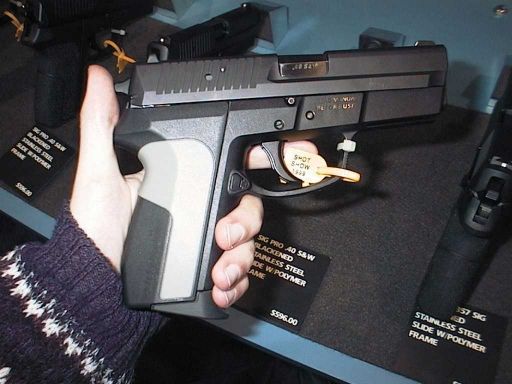
The rubber grip pictured is bulkier and thus you get a longer trigger reach – if you find the trigger reach of the P226 about right then you’re going to need the rubber grip for the SIG Pro. The grip pictured is actually a prototype, the production ones are black. While we’re on the subject of colour, I should mention that the slide is stainless steel and coated with something called: “Nitron”. Anyway, it is corrosion resistant, as is stainless steel, which corrects one of the leading complaints about the P226, namely that it rusts too easily.
I think I should mention the magazine, which was taken from the P229, in fact this prototype actually had a P229 magazine in it:
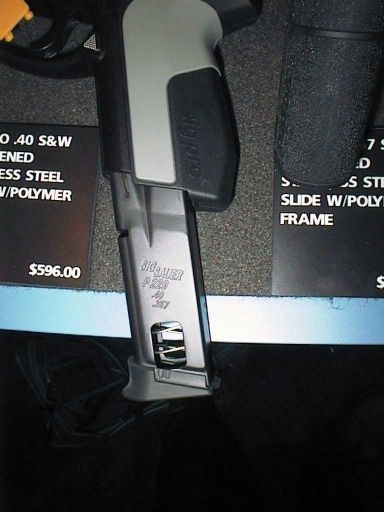
The only difference was the floorplate! There are two different floorplates for the SIG Pro, the one pictured and a shorter one similar to the one used on the P229. The Gendarmerie will be getting one of each with their SP2022s, the shorter one is supposed to be used while wearing plain-clothes. (The French have also ordered 270,000 each of a concealment holster and a duty holster. The duty holster is quite clever and features a permanent thumb strap, the gun is unholstered by rocking it back and out from under the restraint – a clever way of stopping someone from disarming you from the front. They’ve also ordered bolt-on torches for their guns too, the gun can be holstered with the light attached, apparently.)
The magazine for the SP2009 looks like this:

It’s made by Mec-Gar in Italy and holds 15 rounds of 9mm. It’s shorter than usual due to the fact it uses the fatter body of the P229 magazine. This one has inspection holes down the side, however the magazines for the SP2022 have holes down the back similar to the design of the Glock magazines.
One thing I should mention before I go any further is that the French version has a lanyard loop at the bottom of the grip, and more interestingly has a chip embedded in the frame that is encoded with the serial number of the gun as well as the name, unit, sex, and strong hand (left or right) of the officer it’s issued to.
Talking about the insides of the pistol, the SIG Pro takes a page out of the book of the SIG P210 and has a removable fire control unit:

If you look at the edge of the frame, you will see two pins, one near the top of the picture and another near the bottom that can be knocked out, then the whole unit can be slid off the frame. It makes fixing the pistol easier, and apparently the French liked this feature, which the P2000 lacks. However, as you can see the mechanism was designed with typical Teutonic engineering efficiency. It’s reliable, but the quality of the trigger pull is not the best. Note also at the top of the mechanism the rear slide rail – you can also just see on the extreme right the forward slide rail that forms part of the locking insert. This is notable because most pistol designs using a plastic frame have the rails molded into the frame, but not on the SIG Pro.
The SIG Pro, being made in Germany, also has German proofmarks on the barrel, slide and frame:
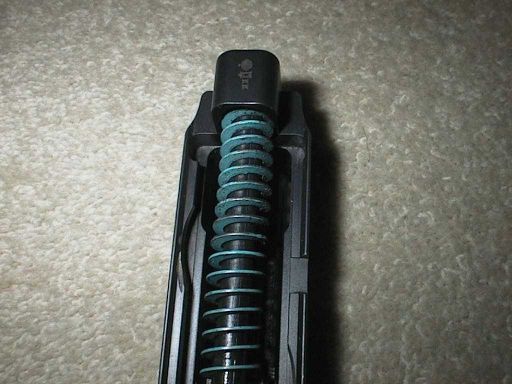
You can see these near the muzzle end of the slide in this picture, if you look closely you can make out the letters: “KK” next to the proofmarks, which indicate it was proved in 1999. Unfortunately, you can only see the proofmarks on the slide by disassembling the gun, which is a bit silly, and the French obviously agree because on the SP2022 they’ve moved them to the right-hand side of the slide in front of the ejection port, and the SP2022 also has a serial number on the slide as well as the frame and barrel. Guns sold in the US have no proofmarks apparently, they’re shipped over in kit form and assembled there.
In this picture you can see the sights on the SP2009:
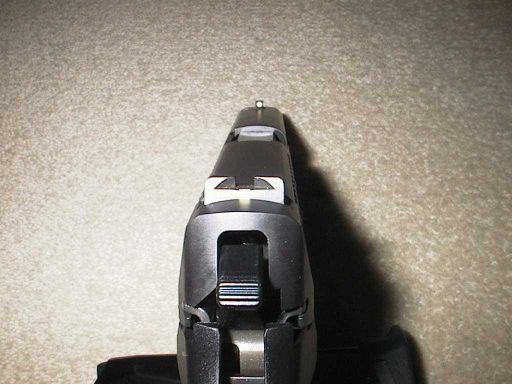
And very good sights they are, personally I think Sauer put the best fixed sights on their pistols. They’re very clear, not too small, not too big, and the rear sight notch is just the right width.
In the next picture you can see the muzzle of the pistol:
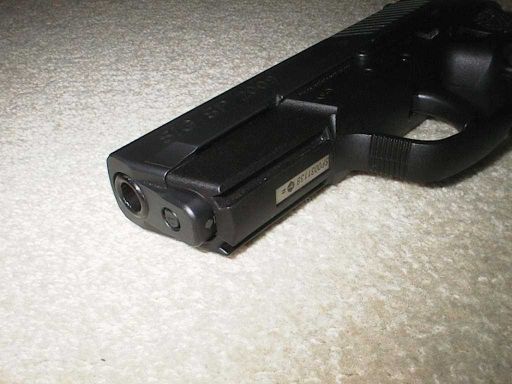
Note that you cannot see all of the proofmark! The serial number is embedded in the frame in a similar manner to other plastic-framed pistols, and the SIG Pro also features cutouts under the muzzle on the frame for attaching various gizmos. On the SP2022 these have been replaced with a short Picatinny rail, which is a vastly more sensible idea as there are so many accessories that use that type of rail. The French for reasons known only to themselves have also specified that the SP2022 come with a recurved trigger guard so that people who can’t shoot properly can wrap the forefinger of their support hand around the trigger guard. Why? I suspect they wanted it because the Beretta 92G (PA MAS G1) has it. Also the SP2022 has a loaded chamber indicator, which is one of those irritating versions that pops up when a round is chambered, rather than being built into the extractor. Invariably in my experience these cause malfunctions, but as I haven’t shot an SP2022 I’ll give Sauer the benefit of the doubt.
Anyway, my anorak is getting a bit sweaty so I think I’ll have to draw this article to a close soon. Suffice to say the SIG Pro comes across as a pistol of relatively traditional design, but upon closer inspection subtly includes a lot of interesting features. If you want a SIG Pro to add to your collection of deactivated guns, good luck, it took me ages to find the one pictured here, and if you want an SP2009 I think you’ll be hard-pressed to find one as I suspect the SP2022 will be the standard model from now on. Expect to pay somewhere around £500 if you find one. If you want to look at some pictures of the SP2022, there are some in the French importer’s press release. Look on the bright side, the French currently use 86 different models of handgun, and presumably they’ll become surplus! (Including 110,000 Beretta 92Gs).
The SP2009 and SP2340 (and there’s also a shorter version, called the SIG Pro Compact) come in the standard cardboard box with instructions, two magazines and a test target, but the SP2022 comes in a plastic box with two magazines, a magazine loader, cleaning rod and brush, a bottle of oil, a breech flag and a fake plastic barrel for training purposes. Or at least the French Government ones do.
I’ll leave you with a picture of the other side of it:

